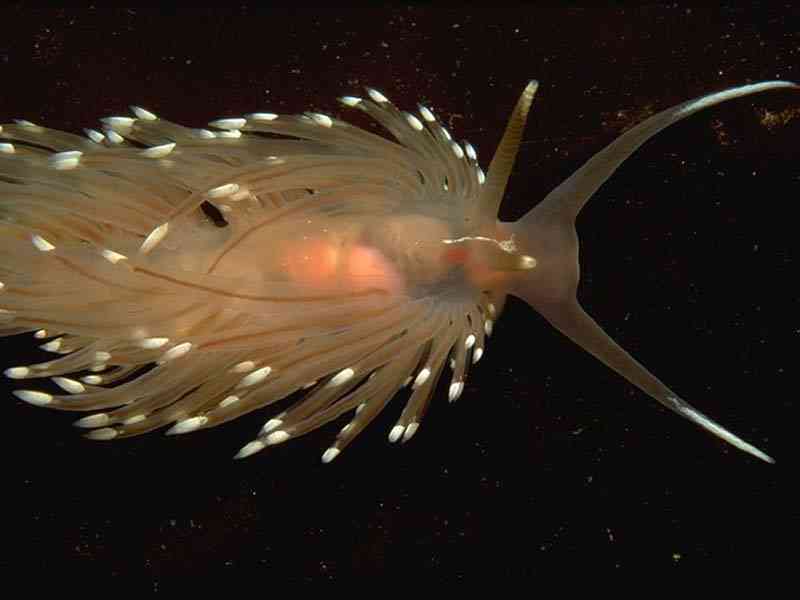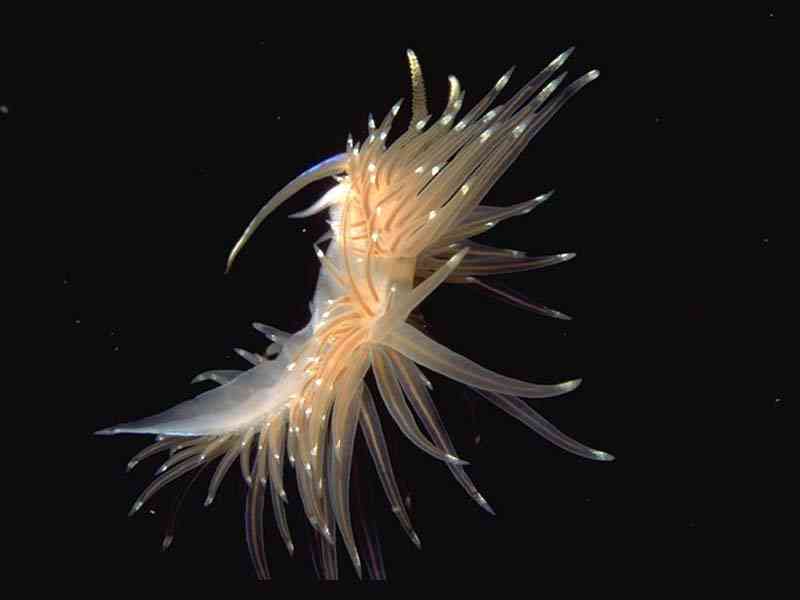Boston facelina (Facelina bostoniensis)
Distribution data supplied by the Ocean Biodiversity Information System (OBIS). To interrogate UK data visit the NBN Atlas.Map Help
| Researched by | Andrew Hosie | Refereed by | Admin |
| Authority | (Couthouy, 1838) | ||
| Other common names | Drummond’s facelina | Synonyms | Facelina auriculata var. curta , Facelina curta Alder & Hancock 1843, Facelina drummondi Alder & Hancock 1848, Facelina gigas Costa 1866 |
Summary
Description
Up to 5.5 cm long with a translucent white body that is tinged rose-pink, Facelina bostoniensis is the largest facelinid nudibranch in British waters. The area surrounding the mouth is typically red and the red oesophagus is visible externally behind the rhinophores. The rhinophores bear up to 30 conspicuous lamellae and are shorter than the oral tentacles, which can be half the body length. The dorsal cerata are arranged in up to 8 clusters.
Recorded distribution in Britain and Ireland
Found all around the British Isles, but less common around the southeast coast of England.Global distribution
Found on both sides of the North Atlantic Ocean. In Europe from southern Norway to the Iberian Peninsula and the Mediterranean.Habitat
Found sublittorally on species of the hydroid Tubularia, or intertidally on species of the hydroid ClavaDepth range
-Identifying features
- Body translucent white, with red oral area and oesophagus.
- Oral tentacles longer than rhinophores, up to 1/2 length of body.
- Cerata arranged in up to 8 clusters.
- Cerata up to 1/3 to 1/2 body length.
Additional information
The taxonomic history of Facelina bostoniensis is complicated, and was only relatively recently recognised as being conspecific with Facelina auriculata var. curta. Facelina bostoniensis has a broader body, longer cerata, which can be 1/3 to 1/2 of the body length and lacks a blue irridescent sheen distinguishing it from Facelina auriculata
Listed by
- none -
Bibliography
Datasets
Centre for Environmental Data and Recording, 2018. Ulster Museum Marine Surveys of Northern Ireland Coastal Waters. Occurrence dataset https://www.nmni.com/CEDaR/CEDaR-Centre-for-Environmental-Data-and-Recording.aspx accessed via NBNAtlas.org on 2018-09-25.
Conchological Society of Great Britain & Ireland, 2018. Mollusc (marine) data for Great Britain and Ireland - restricted access. Occurrence dataset: https://doi.org/10.15468/4bsawx accessed via GBIF.org on 2018-09-25.
Conchological Society of Great Britain & Ireland, 2023. Mollusc (marine) records for Great Britain and Ireland. Occurrence dataset: https://doi.org/10.15468/aurwcz accessed via GBIF.org on 2024-09-27.
Fenwick, 2018. Aphotomarine. Occurrence dataset http://www.aphotomarine.com/index.html Accessed via NBNAtlas.org on 2018-10-01
Manx Biological Recording Partnership, 2022. Isle of Man historical wildlife records 1990 to 1994. Occurrence dataset:https://doi.org/10.15468/aru16v accessed via GBIF.org on 2024-09-27.
Merseyside BioBank., 2018. Merseyside BioBank (unverified). Occurrence dataset: https://doi.org/10.15468/iou2ld accessed via GBIF.org on 2018-10-01.
NBN (National Biodiversity Network) Atlas. Available from: https://www.nbnatlas.org.
OBIS (Ocean Biodiversity Information System), 2025. Global map of species distribution using gridded data. Available from: Ocean Biogeographic Information System. www.iobis.org. Accessed: 2025-07-22
Citation
This review can be cited as:
Last Updated: 04/12/2008




